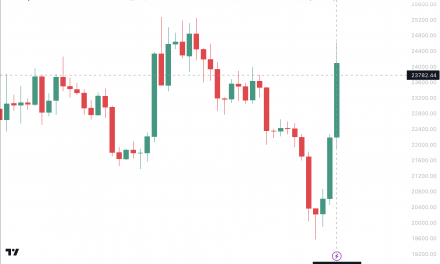Bitcoin’s (BTC) price has been volatile over the past few days, sinking below $30,000 amid a dollar jump and mixed Q1 earnings. The largest cryptocurrency by market capitalization was recently trading at around $29,500, down 2.6% over the past 24 hours. Although Bitcoin rallied above $30,000 last week for the first time since last June, the surge was “largely untested,” according to Joe DiPasquale, CEO of crypto-asset manager BitBull Capital.
Bitcoin’s Struggle for Support and Potential Consolidation
Bitcoin began sinking on Sunday and dropped as low as $29,292 before rebounding slightly, according to CoinDesk data. With Bitcoin sticking around mid-$29,000, most indicators on hourly time frames, such as the Relative Strength Index and Stochastic RSI, hint at a spike upward. However, DiPasquale noted that the recent surge was likely to look for support on the downside and potentially consolidate before another leg up.
Bitcoin’s Price Volatility and Long Squeezes
Coinglass data showed that traders who bet on shifts in price have liquidated over $32 million worth of BTC long positions since Sunday evening versus $1 million of BTC short positions. These types of long squeezes tend to send prices lower, and the recent dip in Bitcoin’s price could be attributed to a combination of factors, including Monday’s U.S. dollar jump and mixed Q1 earnings results.
Macroeconomic Factors Affecting Bitcoin’s Price
Several macroeconomic factors, including Monday’s U.S. dollar jump and mixed Q1 earnings results, might have sent Bitcoin’s price downward, according to Riyad Carey, a research analyst at crypto data firm Kaiko. The U.S. Dollar Index and Bitcoin’s price are negatively correlated, Carey told CoinDesk, adding that this correlation has decreased since the start of the year. These factors could have affected Bitcoin’s price movement, making it more volatile than other assets.
Ether and Other Altcoins Remain Steady
While Bitcoin’s price has been volatile, Ether (ETH) has been holding steady at about $2,084 Monday, down 0.7% in the past 24 hours. This comes after the Ethereum blockchain’s major software upgrade last week. Among other altcoins, Avalanche’s AVAX token recently rallied over 7% to $20.70, and Perpetuals-focused decentralized exchange dYdX’s DYDX token rose by 5% to trade over $3. The CoinDesk Market Index (CMI), which measures the overall crypto market performance, was down 2% in the past 24 hours.
Crypto-related Stocks Drop After Late-Week Surge
Crypto-related stocks also took a hit on Monday after surging late last week. Shares of exchange Coinbase (COIN) and Bitcoin mining firm Marathon Digital Holdings (MARA) lost over 3%, while MicroStrategy (MSTR), a business software company that holds a large amount of Bitcoin, fell 5%. The volatility in Bitcoin’s price is likely to affect these stocks, and investors may be cautious as they watch for any potential rebounds.
Conclusion
Bitcoin’s price has been volatile over the past few days, sinking below $30,000 amid a dollar jump and mixed Q1 earnings results. While some indicators point to a potential spike upward, the recent surge above $30,000 was largely untested, and Bitcoin’s price may need to consolidate before another leg up. These types of long squeezes tend to send prices lower, and several macroeconomic factors, including Monday’s U.S. dollar jump and mixed Q1 earnings results, may have affected Bitcoin’s price movement.





